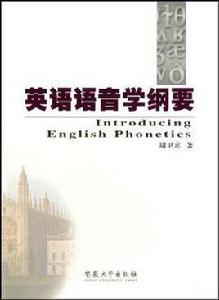內容簡介
《英語語音學綱要》充分吸納了國內外學者在英語語音學和二語習得等相關領域的研究成果,以系統、新穎的方式介紹了英語語音,並在繼承傳統的發聲語音學的基礎上,增加了聲學語音學和感知語音學的內容,使其更具特色。
編輯推薦
《英語語音學綱要》語言簡潔,例證豐富,所附練習針對性強,為語言學與相關專業的本科生、研究生以及英語教學人員深入學習英語語音、開展語音教學與研究提供了有益的參考。
作者簡介
周衛京,女,博士,江蘇科技大學外國語學院副教授、套用語言學研究所所長。
2005年人中國社科院語言所語音實驗室短期研修語音理論和研究方法。2006~2007年人英國劍橋大學語言學系語音實驗室研修英語語音學和實驗語音學。2008年考入英國倫敦大學學院IPA團隊,主修國際音標體系和英語語音教學,獲國際語音學會頒發的IPA英語語音資質證書。
研究方向:套用語言學、二語習得、語音學與實驗語音學。已出版學術專著1部,發表論文20餘篇。參與國家重點社科基金項目1項,主持江蘇省社科、教育基金項目3項,主持校重點教改項目3項。
目錄
Acknowledgements
Preface (序)
Foreword( 前言 )
List of figures
List of tables
1 Introduction
1.1 Phonetics and phonology
1.2 Spoken and written forms in English
1.3 Outline of this book
2 Places and manners of articulation
2.1 The speech mechanism
2.2 The organs of speech
2.2.1 The larynx and vocal folds
2.2.2 The articulators above the larynx
2.3 Places of articulation
2.4 Manners of articulation
Exercises
3 Description and classification of speech sounds
3.1 Phonetic and phonological description
3.2 The classification of speech sound
3.2.1 Vowels and consonants
3.2.2 Classification of English consonants
3.2.3 Classification of English vowels
3.3 The transcription of speech sound
3.3.1 Board and narrow transcription
3.3.2 International Phonetic Alphabet
Exercises
4 Acoustic components of speech
4.1 The nature of speech sound
4.2 The sources and filters
4.3 The acoustic spectrum
4.3.1 Oscillogram(waveform)
4.3.2 Fundamental frequency: pitch
4.3.3 Formants
4.3.4 Spectrogram
Exercises
5 Plosives
5.1 Introduction
5.2 Phonetic features of English plosives
5.2.1 Places of articulation
5.2.2 Force of articulation
5.2.3 VOT and aspiration
5.2.4 Voicing
5.2.5 Release
5.2.6 Pre-fortis clipping
5.3 The phoneme/p/
5.3.1 General considerations
5.3.2 Spellings
5.3.3 Sound distribution
5.3.4 Articulation
5.3.5 Acoustics
5.4 The phoneme/b/
5.5 The phoneme/t/
5.6 The phoneme/d/
5.7 The phoneme/k/
5.8 The phoneme/9/
Exercises
6 Fricatives and affricates
6.1 Introduction
6.2 Phonetic features of English plosives and affricates
6.2.1 Places of articulation
6.2.2 Force of articulation
6.2.3 Voicing
6.2.4 Length
6.2.5 Acoustic characteristics
6.3 The phoneme/f/
6.4 The phoneme/v/
6.5 The phoneme/0/
6.6 The phoneme/6/
6.7 The phoneme/s/
6.8 The phoneme/z/
6.9 The phoneme/I/
6.10 The phoneme/3/
6.11 The phoneme /h/
6.12 The phoneme/tJ/
6.13 The phoneme /d3/
Exercises
7 Nasals and appr0ximants
7.1 Introduction
7.2 Phonetic features of English nasals and approximants
7.2.1 Places of articulation
7.2.2 Vocalic nature of nasals and approximants
7.2.3 Voicing
7.2.4 Acoustic characteristics
7.3 The phoneme/m/
7.4 The phoneme/n/
7.5 The phoneme/r3/
7.6 The phoneme/j/
7.7 The phoneme/w/
7.8 The phoneme/r/
7.9 The phoneme/1/
Exercises
8 Pure vowels
8.1 Introduction
8.2 Phonetic features of English pure vowels
8.2.1 Places of articulation
8.2.2 Vowel length
8.2.3 Acoustic characteristics
8.2.4 Acquisition of pure English vowels
8.3 The Phoneme/i:/
8.4 The Phoneme/I/
8.5 The Phoneme/e/
8.6 The Phoneme/e/
8.7 The Phoneme/u:/
8.8 The Phoneme/o/
8.9 The Phoneme/o:/
8.10 The Phoneme/D/
8.11 The Phoneme/a:/
8.12 The Phoneme/3:/
8.13 The Phoneme/e/
8.14 The Phoneme/A/
Exercises
9 iphthongs
9.1 Introduction
9.2 Phonetic features of English diphthongs
9.2.1 Places of articulation
9.2.2 Vowel length
9.2.3 Acoustic characteristics
9.3 The Phoneme/aft
9.4 The Phoneme/af/
9.5 The Phoneme/ef/
9.6 The Phoneme/ao/
9.7 The Phoneme/eo/
9.8 The Phoneme/io/
9.9 The Phoneme/co/
9.10 The Phoneme/ue/
Exercises
References
Glossary

